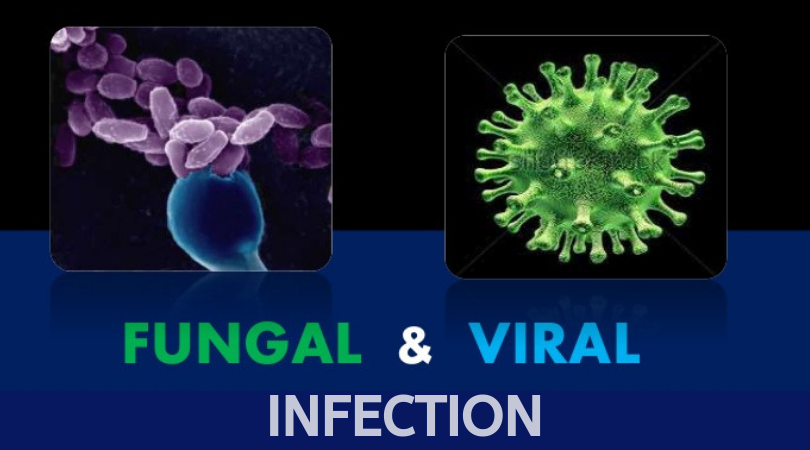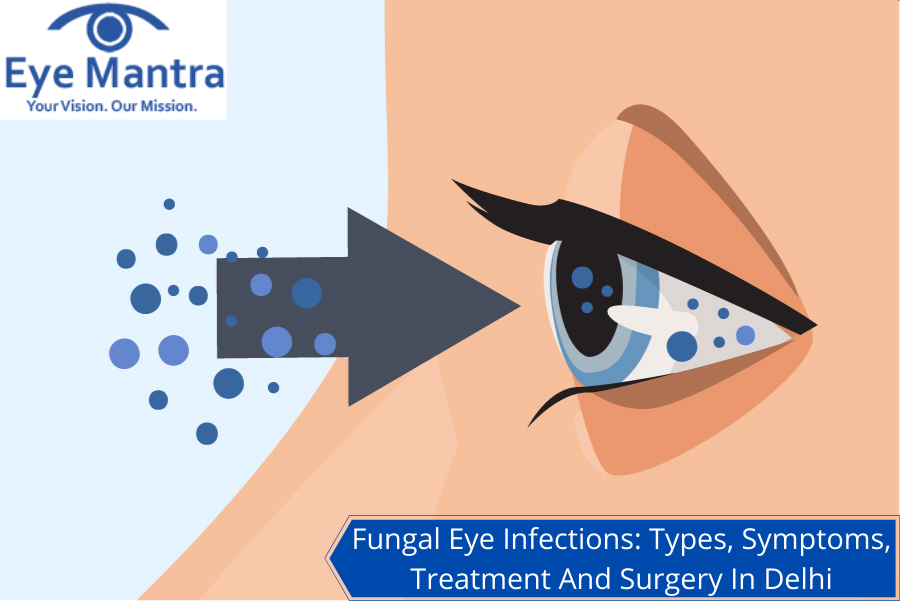Contents
What Are Fungal Eye Infections?
Fungal eye infection can show itself up in many different ways which depends mainly on the part of the eye where the infection has taken place. There are different kinds of eye infections– pink eye or conjunctivitis, Keratitis, Stye, fungal eye infections, Uveitis. Conjunctivitis is the infection of the conjunctiva. It can be caused by bacteria or viruses and also by allergic reactions. Viral conjunctivitis normally settles on its own and does not need any particular treatment. Allergic conjunctivitis can be managed by pouring cool water over the face. Bacterial conjunctivitis too resolves without treatment. Antibiotics may be needed.
Conjunctivitis due to chemicals is treated with the aid of irrigation with Ringer’s lactate or saline solution. Keratitis is a situation in which the eye’s cornea becomes inflamed. Treatment depends on the cause of keratitis. A stye is also known as hordeolum which is a bacterial infection of an oil gland in the eyelid. Most cases settle on their own without eye care. Can also be prescribed with warm compresses. Uveitis is the inflammation of the uvea which is typically prescribed with glucocorticoid steroids either as topical eye drops or as an oral treatment. Antimetabolite medications are frequently used.
Types of Fungal Eye Infections
Fungal infections can attack different segments of the eye.
- Keratitis is a disease of the clear, front layer of the eye (the cornea).
- Endophthalmitis is an infection of the inside of the eye (the vitreous and/or aqueous humour). There are 2 kinds of endophthalmitis: exogenous and endogenous. Exogenous fungal endophthalmitis occurs after fungal spores insert into the eye from an external source. Endogenous endophthalmitis occurs when a bloodstream infection (for example, candidemia) flows to one or both eyes.
Fungi That Cause Eye Infections
Several types of fungi can create eye infections. Common types include:
- Fusarium – a fungus that exists in the environment, particularly in soil and on plants
- Aspergillus – a common fungus that resides in internal and external environments
- Candida – a species of yeast that usually lives on human skin and the protective lining inside the body called the mucous membrane

Symptoms of Fungal Eye Infections
Several symptoms of fungal eye infection are mentioned below:
- Red eyes
- Pain
- Eye discharge
- Watery eyes
- Dry eyes
- Light sensitivity
- Swollen eyes
- Swelling around the eyes
- Itching
- Blurred vision
Anytime you suspect an eye infection, you should always visit your eye doctor for an eye exam. Trying to self-diagnose your condition can delay effective treatment and potentially harm your site.
If you use contact lenses, you should dress only your eyeglasses until you have attended your eye doctor for diagnosis and treatment. There are many various types of eye infections, and your eye doctor needs to determine the specific type of eye infection you have to prescribe the proper treatment.
Your doctor may take a unit from the infected area of your eye for a culture to judge the correct type of infection you have if any. This may assist determine the most adequate treatment, such as an antibiotic that selectively targets the type of bacteria causing the infection.
Treatment For Fungal Eye Infections
The medication for a fungal eye infection depends on:
- The type of fungus,
- The severity of the infection, and
- The parts of the eye are affected.
Desirable methods of medication for fungal eye infections include:
- Antifungal eye drops
- Antifungal medication is given as a pill or through a vein
- The antifungal medication injected directly into the eye
- Eye surgery
All kinds of fungal eye infections must be treated with prescription antifungal medication, normally for numerous weeks to months. Natamycin is a topical (meaning it’s given in the form of eye drops) antifungal medication that runs well for fungal infections including the outer layer of the eye, especially those caused by fungi such as Aspergillus and Fusarium. However, infections that are deeper and more critical may need treatment with antifungal medication such as amphotericin B, fluconazole, or voriconazole. These prescriptions can be given by mouth, through a vein, or injected straight into the eye. Patients whose infections don’t get better after using antifungal medications may need surgery, including corneal transplantation, removal of the vitreous gel from the interior of the eye (vitrectomy), or, in extreme cases, removal of the eye (enucleation).
Alternatives To Fungal Eye Infection Treatment
There are some natural methods of treatment. Like for example, boric acid which is a weak and water-soluble acid serves as an antifungal, antiseptic eyewash. It is better not to use this method if anyone is allergic to it. Flaxseed rich in omega-3 fatty acids stimulates the immune system to fight against infections. It also reduces inflammation and pain of the eye. Teabags can soothe the eye and reduce redness and swelling. Typically, black tea is used for this treatment but green tea or white tea can be used as well. Honey possesses antibacterial properties and is helpful to kill harmful bacteria in the eye. Jasmine flower with boiled or distilled water reduces inflammation, redness, and irritation of the eyes.
Home Remedies For Fungal Eye Infections
Before practising home remedies to treat your eyes, it’s best to discuss with healthcare professionals. Some eye infections can be severe. Discuss with your doctor if you consider you have an eye infection. If you think your kid has an eye infection, take them to a doctor rather than trying these home remedies.
1. Saltwater
Saltwater, or saline, is one of the most powerful home solutions for eye infections. Saline is similar to teardrops, which is your eye’s way of generally cleansing itself. Salt also has antimicrobial characteristics. Because of this, it only stands to reason that saline can heal eye infections effectively. Sterile saline solution can be purchased online or from a drugstore.
2. Teabags
Placing cooled tea bags on your eyes while they’re closed can be a way to rest and unwind. Some say that it can be an adequate home remedy for eye infections.
Some kinds of tea have anti-inflammatory, soothing properties. For instance, studies have suggested that green tea, chamomile, rooibos Trusted Source, and black trusted Source all have anti-inflammatory characteristics. Because of this, using tea bags on your eyes could be a useful way to reduce swelling.
So far, there aren’t any studies that confirm how teabags affect the eyes, or whether they can be applied to treat eye infections. Bear in mind that while anti-inflammatory treatments can relieve the symptoms, an eye infection should be operated at the cause.
3. Warm Compress
If your eyes are sore, infected, or irritated, a warm compress can assist. A 2014 study. Trusted Source on 22 participants recommended that warm compresses can improve eye health in those with healthy eyes.
A 2012 review of studies Trusted Source explained that warm compresses can support those with blepharitis, a condition that involves the eyelid becoming inflamed and crusted. Also, the American Academy of Ophthalmology suggests using a warm compress to relieve the indications of pink eye.
Warm compresses might be able to comfort styles trusted Source because they overcome the blockages that caused the stye. They can also help relieve the symptoms of dry eye Trusted Source. It’s essential to note that, while warm compresses might give relief, they can’t cure the condition.
Here are some tips for making a warm compress:
- Soak a cloth in warm water and apply it gently to your eye
- Use hot, but not too hot, water so you don’t burn yourself
- Make sure the cloth you use is clean, so you don’t expose your eye to more germs
4. Cold Compress
Like warm compresses, cold compresses don’t specifically cure eye infections. They can, however, relieve the discomfort associated with specific eye diseases. Cold compresses can overcome swelling in the case of eye injuries and infections.
Here are suggestions for making a cold compress:
- Soak a cloth in cool water and gently apply it to your eye or eyes
- You can also freeze a wet cloth in a sealable plastic bag for a few minutes before using it on your eyes
- Don’t press down hard on your eye or put ice directly on your eye or eyelid
5. Wash Linens
Wash your towels and pillowcases regularly when you have an eye infection, like conjunctivitis. Since these items come in contact with the infected eye, they can reach the infection to the other eye, or cause someone else in your family to catch an infection. Use hot water and detergent to eliminate any remaining bacteria.
6. Discard Makeup
We all know not to share eye makeup, such as mascara, eye shadow, and eyeliner, to avoid something like eye infections. But you should also drop your eye and face makeup, and makeup brushes, if you used them while you had an infected eye. This assures that you won’t re-infect yourself.
Recovery Period For Fungal Eye Infection
Different types of infections require different recovery periods. Conjunctivitis generally does not need any treatment and can get resolved within a week. But in case of severe conditions, it may require time. A stye can get cured in a few days or weeks. Keratitis is caused by various agents and recovery time will depend on the cause and severity of the disease.
Conclusion
Fungal eye infections are very rare, but they can be very severe. The most common way for someone to grow a fungal eye infection is as a consequence of an eye injury, especially if the injury was caused by plant material such as a stick or a thorn. Inflammation or infection of the cornea (the clear, front layer of the eye) is recognized as keratitis, and inflammation or infection in the interior of the eye is termed endophthalmitis. Several distinct types of fungi can cause eye infections.
For any surgeries related to eyes do visit our website Visit the best Eye Hospital Delhi Now!!!
Call +91-8851044355 and book an appointment. You also mail at [email protected].
Our team of great and experienced ophthalmologists will advise the best options for safely and effectively treat your dry eyes. Remember if you have any concerns about your eyes, from Retina Surgery, Specs Removal to Cataract Surgery.
You may also check:
Do’s and Dont’s for protecting your eyes while playing holi



